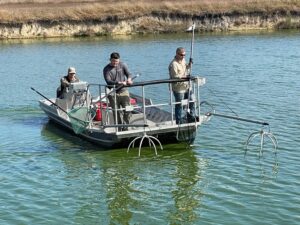Although electrofishing equipment is effective at any time of the year, most fisheries biologists recommend autumn sampling dates. Not only is it more comfortable for the workforce, but there are several important reasons why October-November is the optimum time to assess gamefish populations.

Electrofishing Boat
Electrofishing surveys are more accurate in Autumn
After the dog days of summer have passed, a largemouth bass’ appetite kicks into high gear. Bass will move into shallow water and gorge themselves on sunfish, shad, and crayfish in preparation for the oncoming winter. The resulting weight gain will help carry them through the colder months when their metabolism is reduced and feeding periods are shortened. This seasonal change in feeding habits benefits fish surveys in two ways. One, it congregates bass in shallow water which increases the catch rates of electrofishing. Second, it allows fisheries managers to evaluate the bass population during its healthiest condition. Both of these favor a more comprehensive assessment of the fish population in your lake or pond.
Spring fish surveys can be inaccurate, and stress spawning females
Anglers may argue that bass are in their best condition during the spring “pre-spawn” period. However, springtime assessments can artificially inflate certain data that we use to evaluate the health of the population. For example, pre-spawn females will be full of eggs at this time. This significantly increases the body index called Relative Weight, which we use to gauge the body condition or “fatness” of gamefish. Autumn surveys provide a more accurate measure of efficient feeding and overall bass health. When done correctly, electrofishing equipment is harmless to fish; however, removing large females off of spawning nests can be stressful on the bass.

Obtaining Length & Weight Data
Electrofishing during the heat of the north Texas summer is never recommended
Gamefish naturally become stressed during periods of extended heat. This makes them more susceptible to infections and possible death due to improper handling. Therefore, we do not perform electrofishing services when water temperatures exceed 80 degrees.
When performing a fish survey, fisheries biologists look at several different things. Aside from the body condition of individual bass, we also look at important factors like size structure, reproductive success, and growth rates of both bass and forage species. By the time October arrives, the “young-of-the-year” fish have had ample time to grow large enough to be captured using electrofishing gear. Therefore, autumn electrofishing allows biologists to analyze all age classes and to forecast any size structure changes or foraging problems that may occur the following year.
Consult with your biologist at Magnolia Fisheries and schedule your fish survey today!
